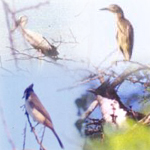Join Us
Feed Back
Contact Us
Fawn's Club
Do's and Dont's
Home



| About Us | Activities | Flora & Fauna | Campaigns | Interesting Links | Wildlife Helpline |
| Previous |
|
Next |
News Join Us Feed Back Contact Us Fawn's Club Do's and Dont's Home 
|
|
 |
||||
|
It is slightly smaller than a sparrow. In breeding plumage, its upperparts are chocolate-brown; lower parts are white, speckled with black. In non-breeding and immature plumage, it is more or less plain brown. Both sexes are alike. It is found in flocks, about open cultivation. Its habits are typical of a munia. It flocks sometimes up to 200 or more, hopping about gleaning grass seeds, etc. The birds also occasionally also devour winged termites emerging from the ground, and when disturbed fly up into trees and bushes, uttering feeble chirrups. Its nesting season is chiefly July to October. Its nest consists of a globular structure of grass blades like other munias', about 20 cm across, and with a lateral entrance hole near the top. Both sexes share domestic duties
|
||||
| HOME |